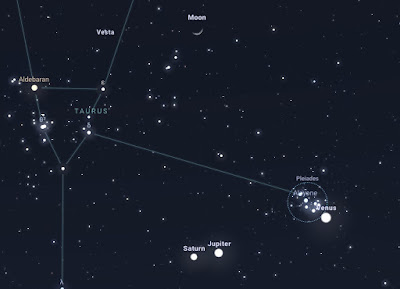The science writers are at it again, hawking the "Grand Conjunction" of Saturn and Jupiter that will take
place on December 21, 2020 as a bright Christmas Star for all to see. On that evening the two planets will be a
scant 0.1° apart, close enough that they should both comfortably fit
into most amateur telescopes at low to medium power. It is clearly a special occasion since the last time these two giants were visible this close together in the night sky was 1226 when St. Francis of Assisi was around. Of course there's also the fringe media that is having a ball with it, claiming this alignment at Winter solstice is a bad omen (just search for "grand conjunction 2020 predictions").
Hype aside, amateur astronomers are indeed excited to witness this alignment. Roughly every twenty years Jupiter catches up with Saturn, pairing up with it in the heavens. In 1980 and 2000 they got to within about 1¼° of each other, and will do so again in 2040. But the 2000 and 2040 alignments suffer from Sun glare, making the spectacle hard or impossible to appreciate. The spring of 2060 should deliver a mega hit to any conjunction junkie with Jupiter and Saturn getting within about 1 degree of each other amid Taurus while Venus threads her way through the Pleiades and a crescent Moon thrown in for good measure on the night of April 4th!
 |
| Grand Conjunction of 2060 |
So, looking at that Stellarium Online image of the conjunction on the night of April 4th in 2060, did you get excited? Did you think, "Wow, don't want to miss that!" (assuming you're under 40)? What is it about these gatherings of celestial orbs that makes the amateur astronomer circle the date on their calendar in expectation?
I think some of it relates to the yin-yang aspect of our hobby. On the one side we have the "passive" sense of the heavens. They are consistent, steady, predictable. There is something almost reassuring seeing Orion raise up from his side on a late October evening. We know that almost nothing of shallow or deep space has altered much since Galileo's first scope or Messier's compilation of faux comets. When I say "Albireo" your mind's eye brings forth a beautiful double star. Like travelers who've embarked on a country wide road trip to see the sights, we revel in comparing notes and swapping photos of the cool things we've visited.
And then there's the "active" side of the night sky. Here we seek to catch ephemeral sights that may be constrained by location or good fortune. You venture out under cold, clear December skies on the 12th in hopes of catching a Geminid that is spectacular. We trek across country or even across continents in hopes of catching a few minutes of the solar corona. These two examples categorize the action; some of it is somewhat random (meteor showers, super novae, sunspots, aurora) while others are anticipated.
Most of that predictable action centers around alignments. Conjunctions, eclipses, occultations, transits - all provide opportunities to experience something that ranges from uncommon to very rare. And while we have the sublime beauty of Saturn's rings or wispy tendril's of Orion's sword available to us on any clear night when they lie above the horizon, the beauty of a celestial alignment is often brief and may not be repeated in your lifetime. I doubt I shall ever see another Mercury transit but hope to work in another total eclipse.
Thankfully the universe is like a top chef at a 5 star restaurant, continually serving up one delightful alignment dish after another. In spring we had the octennial passage of Venus through the Pleiades, in fall we had a generational opposition of Mars. And now we get something even more uncommon, a "grand conjunction" of Jupiter and Saturn to close out a rather tedious year. So go out there and try to see it, photograph it, soak it in as yet another special occasion brought to you courtesy of the universe!
 |
| Jupiter & Saturn Drawing Together on Dec 8, 2020 |

No comments:
Post a Comment